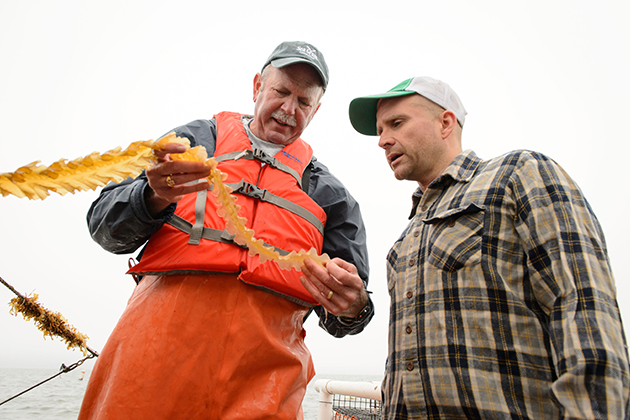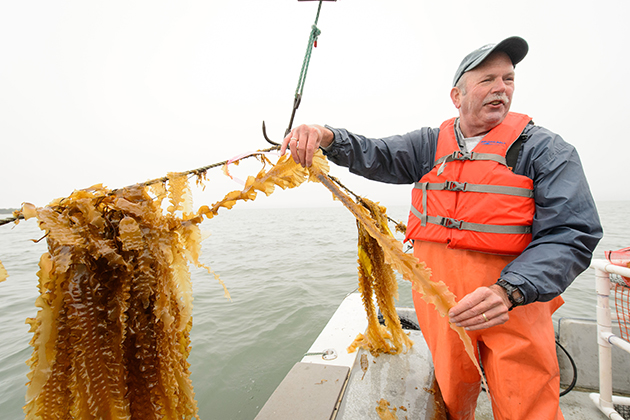Charlie Yarish pulls a long strand of kelp out of the chilly waters of Long Island Sound and takes a bite.
“Oh, that’s good,” he says. “Crisp and sweet. You can’t beat it when it’s fresh.”
It’s just another day at the office for Yarish – “Captain Seaweed” – a professor in UConn’s departments of Ecology and Evolutionary Biology and Marine Sciences, who is using the expertise that’s made him a globally renowned seaweed specialist to help birth an entirely new industry up and down the East Coast.
Yarish, a tall, gregarious New York native with a brushy mustache and an infectious enthusiasm for his work, envisions a day when seaweed farms, using techniques developed at the University of Connecticut, stretch from one end of Long Island Sound to the other, producing a crop worth potentially more than $47 million annually.
But first, he’s got to get that strand of kelp off the boat and onto your dinner plate.
Growing sea vegetables
The process starts in the waters of Long Island Sound, where Yarish, assistant research professor of marine sciences Jang Kim, and others harvest the reproductive tissue from the seaweed that they then transport to Yarish’s lab at UConn’s Stamford campus. There, the tissue releases hundreds of thousands of spores that are grown under ideal lab conditions until they’re ready to be taken back out to sea and planted on a seaweed farm.
Yarish’s lab produces summer and winter varieties of different seaweeds, meaning the industry can function year-round. Once the plants are ready for harvest, fishing boats use grappling hooks to haul up long lines covered in crisp seaweed, which is then cut, bagged, and taken to Bridgeport for processing.
From there, it goes to a growing number of restaurants and chic markets, where the flavorful, nutritious plant is gaining in popularity. Among the companies working with Yarish to explore seaweed’s full potential is Maine-based Ocean Approved.
“I call them sea vegetables rather than seaweed,” Yarish says, “because that’s a more accurate description. Just like vegetables, they’re high in nutrients, vitamins, and trace elements, and they’re good for you, and they’re delicious. They can be made into pasta noodles and are gluten free.”

They’re also coming along at a time when more and more Americans are thinking hard about what goes onto their plate, from whether it’s healthy, to how it was produced. Seaweed pushes all those locavore, organic, health-conscious, and foodie buttons, which is what drew Bren Smith to Yarish’s research.
Smith is the owner of the Thimble Islands Oyster Co. and captain of the fishing boat on which Yarish was happily crunching away on some kelp recently. Having done longline fishing in the Bering Sea and lobstering off Massachusetts, Smith, in his flannel shirt and Whalers cap, looks every inch the classic New England fisherman. But he’s also business-savvy and environmentally conscious, two traits that make seaweed farming a natural fit.
“We’re hoping seaweed is going to be the next kale,” Smith says, referring to the once-doughty winter vegetable which has become trendily omnipresent in recent years.
One of the ways that’s going to happen is by getting the word out that seaweed isn’t just for sushi, although that’s probably how most people have encountered it as food.
Ocean Approved, a company that uses Yarish’s research in its harvesting, makes pasta noodles out of kelp, for instance, and notes that kelp has more fiber than brown rice, more calcium than whole milk, and more iron than spinach.
In trendy Manhattan restaurants like Louro, seaweed-featuring dishes have ranged from kelp pasta with crab to pork belly with kelp salad to scallops and rice tossed in a kelp vinegar. The ritzy New York City “cocktail consultants” Evoe recently teamed with Louro and Smith to offer a special night of seaweed dishes and cocktails, like the Green Blood Maria, with kelp, chilies, and tomatoes, and the Sovereign Remedy, made with kelp-infused whiskey.
Seaweed can be used in countless other recipes, too, from wraps to soup to scrambled eggs, but the interest in cutting-edge New York eateries is an important step, Smith says.
“When something catches on in New York, it usually spreads pretty quickly to the rest of the country,” he says.
Improving water quality

Seaweed, of course, has other uses: Yarish’s research, recently funded, in part, by Connecticut Sea Grant, originally focused on the plant’s value in reducing water pollution in coastal waters. One of Yarish’s seaweed farms is at the confluence of Bronx and East Rivers in the Bronx, where the plants soak up nitrogen dumped into the water by nearby waste treatment plants and nutrients entering the watershed. This is one of the aspects that attracts green-minded businesses like Smith’s: just by growing the seaweed, nutrient pollution is reduced.
“If someone sees the floats from our lines from their beach house in Fairfield, they should know we’re improving their water quality,” Yarish says.
When Yarish and Timothy Dowding, a professor-in-residence at Stamford, began brainstorming ways the nutrient extraction properties of seaweed could be twinned with other uses, Yarish says they kept finding new applications for what he calls “the virtuous vegetable”: animal feeds, biofuel, plant fertilizers, colloids (including alginates and agars), textiles, paper.
All of those may prove to be lucrative economic development paths, but for now, Yarish is concentrating on turning seaweed – sea vegetables – into a mainstay of American menus.
“There’s nothing like it,” he says, as Bren Smith’s boat bobs in the waters of Long Island Sound. “Eating something that’s really good for you and that tastes great on top of it. How can you beat it?”



